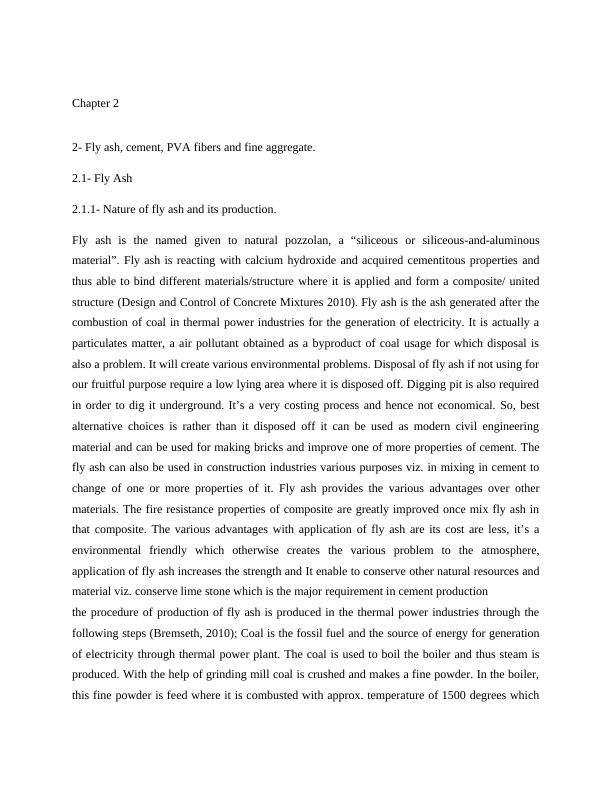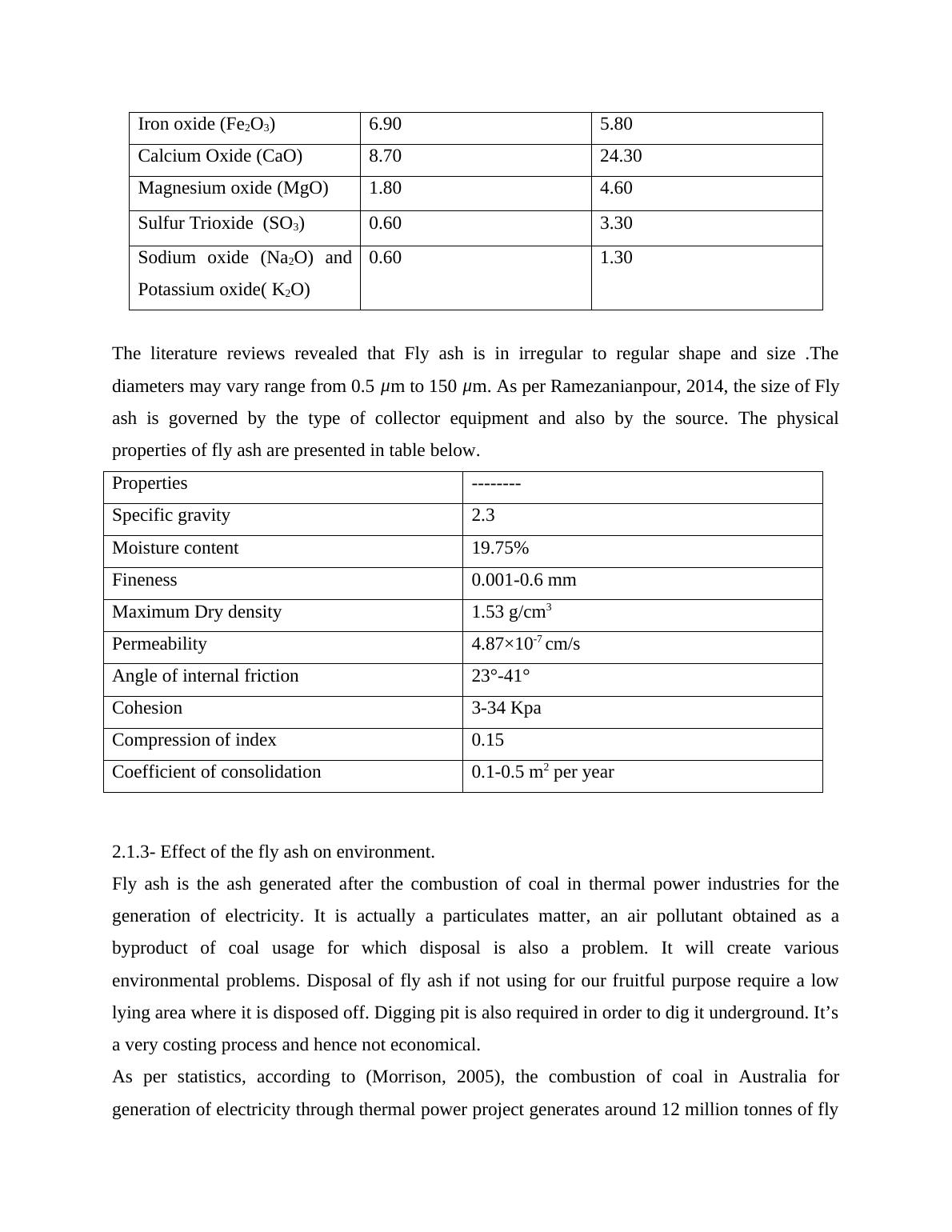Fly Ash Cement pva fibers Assignment PDF
Added on 2021-06-17
9 Pages3059 Words23 Views
Chapter 22- Fly ash, cement, PVA fibers and fine aggregate.2.1- Fly Ash 2.1.1- Nature of fly ash and its production.Fly ash is the named given to natural pozzolan, a “siliceous or siliceous-and-aluminousmaterial”. Fly ash is reacting with calcium hydroxide and acquired cementitous properties andthus able to bind different materials/structure where it is applied and form a composite/ unitedstructure (Design and Control of Concrete Mixtures 2010). Fly ash is the ash generated after thecombustion of coal in thermal power industries for the generation of electricity. It is actually aparticulates matter, a air pollutant obtained as a byproduct of coal usage for which disposal isalso a problem. It will create various environmental problems. Disposal of fly ash if not using forour fruitful purpose require a low lying area where it is disposed off. Digging pit is also requiredin order to dig it underground. It’s a very costing process and hence not economical. So, bestalternative choices is rather than it disposed off it can be used as modern civil engineeringmaterial and can be used for making bricks and improve one of more properties of cement. Thefly ash can also be used in construction industries various purposes viz. in mixing in cement tochange of one or more properties of it. Fly ash provides the various advantages over othermaterials. The fire resistance properties of composite are greatly improved once mix fly ash inthat composite. The various advantages with application of fly ash are its cost are less, it’s aenvironmental friendly which otherwise creates the various problem to the atmosphere,application of fly ash increases the strength and It enable to conserve other natural resources andmaterial viz. conserve lime stone which is the major requirement in cement productionthe procedure of production of fly ash is produced in the thermal power industries through thefollowing steps (Bremseth, 2010); Coal is the fossil fuel and the source of energy for generationof electricity through thermal power plant. The coal is used to boil the boiler and thus steam isproduced. With the help of grinding mill coal is crushed and makes a fine powder. In the boiler,this fine powder is feed where it is combusted with approx. temperature of 1500 degrees which

in turn produce heat. There are two mineral are present in coal, one is combustible and other isnon-combustible. While the combustible mineral burn and produce heat but non-combustibleminerals melts and fuses together in the furnace. These non-combustible minerals are separatedfrom the burning region with the help of exhaust chamber through the exhaust or passes throughflue gases. From the flue gases, these mineral is again separated through the cooling action. Aftercooling, it forms the spherical glassy particles and settled. These glassy particles are known asfly ash and collected by the means of mechanical and electrostatic precipitator. 2.1.2- Physical and chemical properties of fly ash.Since the basic raw material through which fly ash is made is the coal, so the physical andchemical properties are attained by the fly ash is totally depends upon the quality, nature ofprerequisite material coal, and how the coal are processed and operating condition of the furnace.By the nature of coal we mean what are the constituents of coal and how pure the coal is? Inorder to best efficiently use for different purposes, it is urged that the physical and chemicalproperties of flyash are to be known. Based on physical and chemical properties, fly ash can beused for making the flyash bricks or can be mix in cement to change one or more propertiesrequired for different purposes. Based on quality of coal, the chemical composition of fly ash would vary significantly. However,the major constituent of the fly ash is always a Silicon dioxide (SiO2). As per Bremseth, 2010,the chemical contents of flyash is governed by what the composition of different constituentspresent in coal. Based upon the composition of calcium content, the fly ash is classify as class Fand class C. These classifications are given by American Society for Testing and Materials(ASTM) C618-03. In case of class F, the percentage composition of calcium is less while inclass C it is high. Concerns of the quality, the quality of class C fly ash is good and can be usedfor many purposes but class F have limited use. The reason is it contains various unwantedmineral like sulphite and free lime (de Brito & Saikia, 2013). The table below shows thechemical properties of fly ash (Gamage 2011). Chemical CompoundLow calcium fly ashClass FHigh calcium fly ashClass CSilicon dioxide (SiO2)54.9039.90Aluminium oxide (Al2O3)25.8016.70Iron oxide (Fe2O3)6.905.80

Calcium Oxide (CaO)8.7024.30Magnesium oxide (MgO)1.804.60Sulfur Trioxide (SO3)0.603.30Sodium oxide (Na2O) andPotassium oxide( K2O)0.601.30The literature reviews revealed that Fly ash is in irregular to regular shape and size .Thediameters may vary range from 0.5 μm to 150 μm. As per Ramezanianpour, 2014, the size of Flyash is governed by the type of collector equipment and also by the source. The physicalproperties of fly ash are presented in table below. Properties--------Specific gravity2.3Moisture content19.75%Fineness0.001-0.6 mmMaximum Dry density1.53 g/cm3Permeability4.87×10-7 cm/sAngle of internal friction23°-41°Cohesion3-34 KpaCompression of index0.15Coefficient of consolidation0.1-0.5 m2 per year2.1.3- Effect of the fly ash on environment.Fly ash is the ash generated after the combustion of coal in thermal power industries for thegeneration of electricity. It is actually a particulates matter, an air pollutant obtained as abyproduct of coal usage for which disposal is also a problem. It will create variousenvironmental problems. Disposal of fly ash if not using for our fruitful purpose require a lowlying area where it is disposed off. Digging pit is also required in order to dig it underground. It’sa very costing process and hence not economical. As per statistics, according to (Morrison, 2005), the combustion of coal in Australia forgeneration of electricity through thermal power project generates around 12 million tonnes of flyash every years. From which 60 % is dumped in low lying areas. However by doing so maycause various enormous environmental problems including promoting air, water, and landpollutions. Some of the problems are contamination of ground water and ground pollution, fog/smog, asthma, inhalation problems etc.

End of preview
Want to access all the pages? Upload your documents or become a member.
Related Documents
42908 Engineering Project Preparationlg...
|14
|3403
|377
Mechanical Properties of Fly Ash Based Green Concrete Report 2022lg...
|15
|3558
|12
Fly Ash as an Alternative to Cement in Concrete Productionlg...
|23
|5721
|291
Zero/low-carbon design technology to scale the emissions of fossil fuel combustionlg...
|10
|1796
|56
